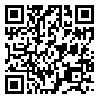جمعه 28 شهریور 1404
[Archive]
دوره 8، شماره 3 - ( 4-1399 )
جلد 8 شماره 3 صفحات 256-243 |
برگشت به فهرست نسخه ها
Download citation:
BibTeX | RIS | EndNote | Medlars | ProCite | Reference Manager | RefWorks
Send citation to:



BibTeX | RIS | EndNote | Medlars | ProCite | Reference Manager | RefWorks
Send citation to:
Baghani E, Fata L, Salehi M, Hasani F. Attentional Bias and Prediction of Attempted Suicide in Clinical and Non-clinical Population. PCP 2020; 8 (3) :243-256
URL: http://jpcp.uswr.ac.ir/article-1-718-fa.html
URL: http://jpcp.uswr.ac.ir/article-1-718-fa.html
Attentional Bias and Prediction of Attempted Suicide in Clinical and Non-clinical Population. Practice in Clinical Psychology. 1399; 8 (3) :243-256
چکیده: (3811 مشاهده)
Objective: the aim of the present research was to analyze the predictability of suicide attempts, based on attentional bias in a clinical and non-clinical population.
Methods: 120 participants (77 females and 43 males) were intentionally selected in three diagnostic groups: clinical suicides, clinical non-suicides, and non-clinical ones (40 individuals in each group). They participated in the Suicide Stroop Task as well as the Beck Scale of Suicide Ideation (BSS). The attentional bias parameters, including reaction time and interference time, were computed and the data were analyzed using Multivariate Analysis of Variance and Discriminant Analysis.
Results: the results obtained from the multivariate analysis revealed that the variables of interference time did not have a significant indication for the three groups of individuals in suicide stroop (P<0.568; F=0.569), positive stroop (P<0.201; F=1.626), and negative stroop (P<0.863; F=0.147). However, in the case of reaction time, there was a significant difference in the values obtained for all the three groups in terms of suicide stroop (P<0.000; F=12.759), positive stroop (P<0.000; F=18.520), negative stroop (P<0.000; F=10.995), and neutral stroop (P<0.000; F=8.288). In addition, the results obtained from the discriminant analysis show that the variables of suicide ideation (0.822), reaction time in positive stroop (0.571), suicide stroop (0.470), negative stroop (0.438), and neutral stroop (0.376) were correspondingly crucial in predicting the behavior of the clinical suicide attempt, clinical non-suicide attempt, and non-clinical groups.
Conclusion: We found that for suicide stroop, the clinical and non-clinical cases did not show a significant difference in terms of the interference effect; however, they differed in terms of reaction time. Therefore, it seems that using emotional stroop, attentional bias towards suicide-related topics is not dependent on the clinical situations, and other parameters, such as scoring methods should be considered. However, there is still a need to conduct more extensive studies.
Methods: 120 participants (77 females and 43 males) were intentionally selected in three diagnostic groups: clinical suicides, clinical non-suicides, and non-clinical ones (40 individuals in each group). They participated in the Suicide Stroop Task as well as the Beck Scale of Suicide Ideation (BSS). The attentional bias parameters, including reaction time and interference time, were computed and the data were analyzed using Multivariate Analysis of Variance and Discriminant Analysis.
Results: the results obtained from the multivariate analysis revealed that the variables of interference time did not have a significant indication for the three groups of individuals in suicide stroop (P<0.568; F=0.569), positive stroop (P<0.201; F=1.626), and negative stroop (P<0.863; F=0.147). However, in the case of reaction time, there was a significant difference in the values obtained for all the three groups in terms of suicide stroop (P<0.000; F=12.759), positive stroop (P<0.000; F=18.520), negative stroop (P<0.000; F=10.995), and neutral stroop (P<0.000; F=8.288). In addition, the results obtained from the discriminant analysis show that the variables of suicide ideation (0.822), reaction time in positive stroop (0.571), suicide stroop (0.470), negative stroop (0.438), and neutral stroop (0.376) were correspondingly crucial in predicting the behavior of the clinical suicide attempt, clinical non-suicide attempt, and non-clinical groups.
Conclusion: We found that for suicide stroop, the clinical and non-clinical cases did not show a significant difference in terms of the interference effect; however, they differed in terms of reaction time. Therefore, it seems that using emotional stroop, attentional bias towards suicide-related topics is not dependent on the clinical situations, and other parameters, such as scoring methods should be considered. However, there is still a need to conduct more extensive studies.
| بازنشر اطلاعات | |
 |
این مقاله تحت شرایط Creative Commons Attribution-NonCommercial 4.0 International License قابل بازنشر است. |



